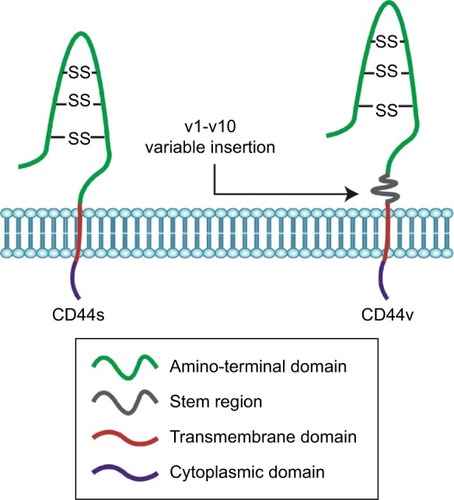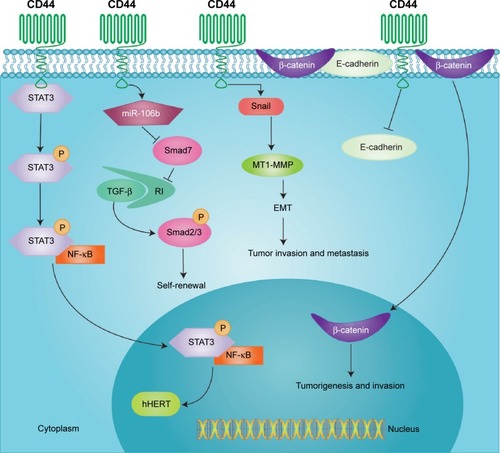Figures & data
Figure 1 Schematic structures of alternative splicing in CD44.
Notes:
CD44 gene contains 20 exons.Citation10 Alternative splicing gives rise to CD44s and CD44v. Exon 1 is an N-terminal signal sequence, exons 2 and 3 are a link module that binds to HA, exons 4, 5, 16, and 17 compose a stem region, exon 18 makes up a single-pass transmembrane domain, and exon 20 forms a cytoplasmic domain.Citation10 Exon 19 is spliced out in all forms of CD44 cDNAs.Citation4 The smallest CD44s is encoded by constant exons 1–5 and 16–20.Citation10 Multiple CD44v is produced by insertion of variant exons (exons 6–15), typically identified as v1–v10. CD44 variant can contain one or more variant regions, such as CD44v3, CD44v6, CD44v4–10, or CD44v8–10. Figure adapted from Chanmee T, Ontong P, Kimata K, Itano N. Key roles of hyaluronan and its CD44 receptor in the stemness and survival of cancer stem cells. Front Oncol. 2015;5:180. Available from: http://journal.frontiersin.org/article/10.3389/fonc.2015.00180/abstract. Copyright © 2015 Chanmee, Ontong, Kimata and Itano.Citation10
Abbreviations: CD44s, CD44 standard; CD44v, CD44 variant; HA, hyaluronic acid; s, standard; v, variant.
Abbreviations: CD44s, CD44 standard; CD44v, CD44 variant; HA, hyaluronic acid; s, standard; v, variant.

Figure 2 Key domains of CD44.
Notes: CD44 protein consists of a short C-terminal cytoplasmic domain, a transmembrane domain, and seven extracellular domains which contain an N-terminal HA-binding link-homology module and stem region. In CD44v, variant exons are inserted into the stem region at the proximal plasma membrane external region. Figure adapted from Misra S, Hascall VC, Markwald RR, Ghatak S. Interactions between hyaluronan and its receptors (CD44, RHAMM) regulate the activities of inflammation and cancer. Front Immunol. 2015;6:201. Available from: http://journal.frontiersin.org/article/10.3389/fimmu.2015.00201/abstract. Copyright: © 2015 Misra, Hascall, Markwald and Ghatak.Citation4
Abbreviations: HA, hyaluronic acid; CD44s, CD44 standard; CD44v, CD44 variant; SS, disulfide bond; v, variant.
Abbreviations: HA, hyaluronic acid; CD44s, CD44 standard; CD44v, CD44 variant; SS, disulfide bond; v, variant.

Figure 3 Representative signal pathways induced by CD44.
Notes: CD44 promotes phosphorylation of STAT3, leading to the nuclear translocation of pSTAT3 and activation of hHERT.Citation26 Upregulation of miR-106b family by CD44 represses inhibitory Smad7, which inhibits TGF-β/Smad2/3 signaling by suppressing TGF-β receptor I (RI) and then enhances self-renewal of cancer cells;Citation47 Snail1 upregulates the expression of membrane type 1-matrix metalloproteinase (MT1-MMP), which promotes tumor invasion.Citation50 CD44 disassociates the formation of the membrane-associated E-cadherin–β-catenin complex, releasing β-catenin translocates into nucleus and activating genes related to cell invasion and migration.Citation46
Abbreviations: TGF-β, transforming growth factor β; EMT, epithelial–mesenchymal transition; miR, micro RNA; P, phosphorous status of moleculars; RI, receptor I; MT1-MMP, membrane type 1-matrix metalloproteinase.
Abbreviations: TGF-β, transforming growth factor β; EMT, epithelial–mesenchymal transition; miR, micro RNA; P, phosphorous status of moleculars; RI, receptor I; MT1-MMP, membrane type 1-matrix metalloproteinase.

